Comprehensive Report: Encryption Techniques in IT Security - MITS5004
VerifiedAdded on 2022/10/11
|9
|2287
|7
Report
AI Summary
This report provides a comprehensive overview of encryption techniques, crucial for IT security. It begins with an introduction to cryptography, emphasizing its role in data integrity, authentication, and confidentiality. The discussion delves into public key and secret key cryptography, differentiating between symmetric and asymmetric ciphers. It explores substitution and transposition ciphers, detailing substitution and transposition techniques. The report further examines stream and block ciphers, including various modes of operation for block ciphers like ECB, CBC, CFB, OFB, and CTR. It then describes stream ciphers, highlighting the role of shift registers and feedback functions. The paper also addresses hybrid algorithms, such as PGP, and concludes with a summary of the key concepts discussed. The report references multiple sources to support its findings, providing a well-rounded understanding of the subject.
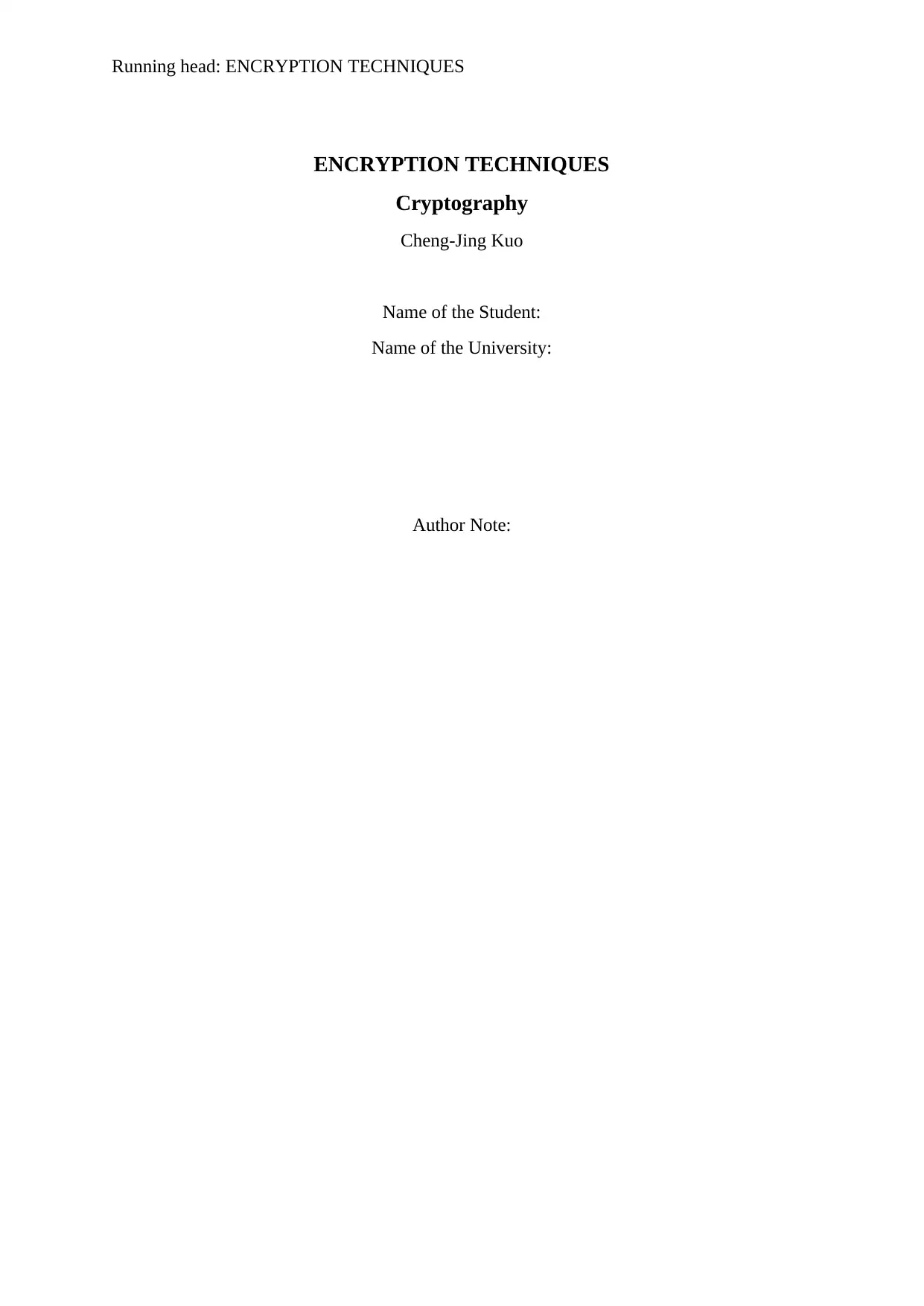
Running head: ENCRYPTION TECHNIQUES
ENCRYPTION TECHNIQUES
Cryptography
Cheng-Jing Kuo
Name of the Student:
Name of the University:
Author Note:
ENCRYPTION TECHNIQUES
Cryptography
Cheng-Jing Kuo
Name of the Student:
Name of the University:
Author Note:
Paraphrase This Document
Need a fresh take? Get an instant paraphrase of this document with our AI Paraphraser
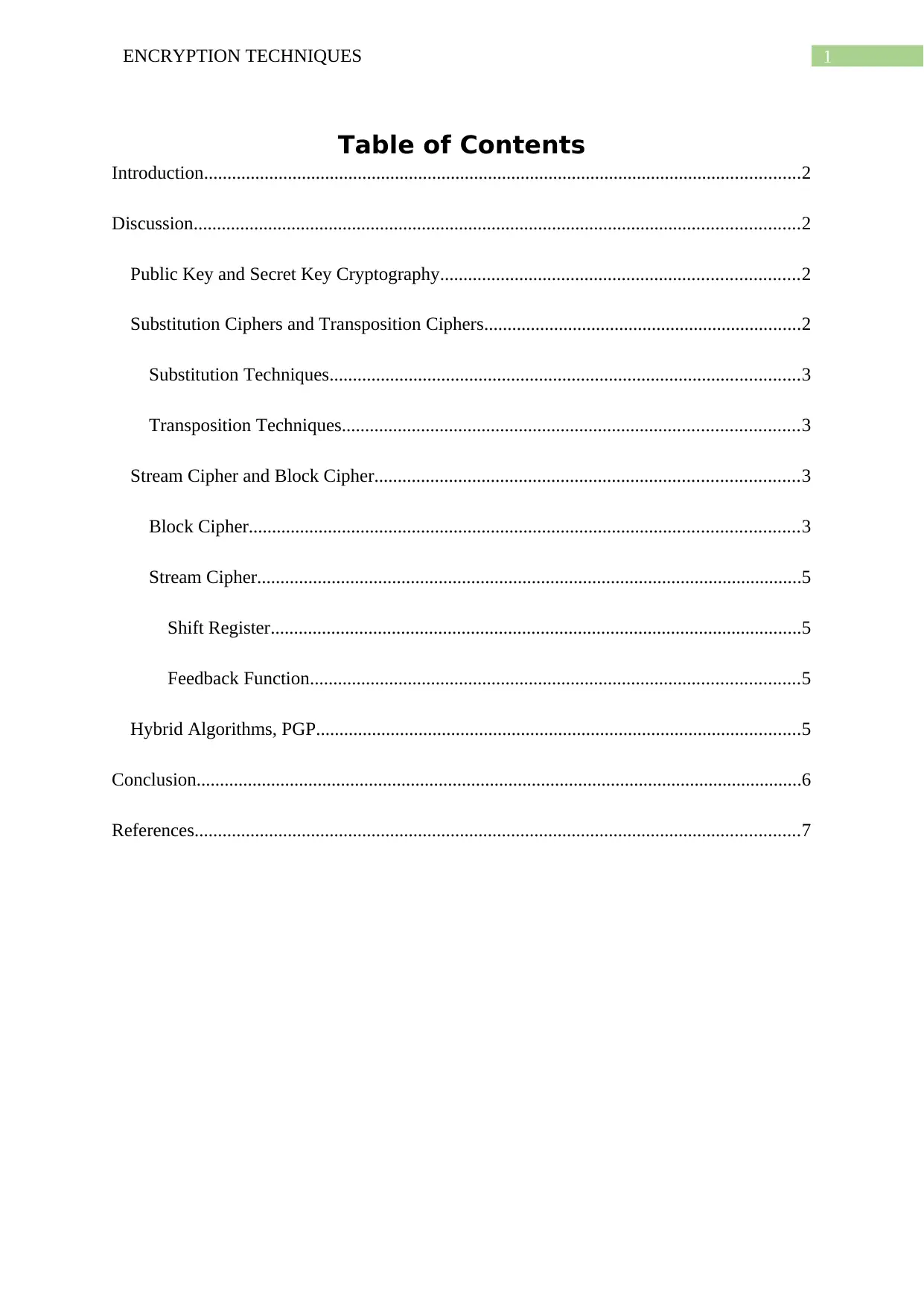
1ENCRYPTION TECHNIQUES
Table of Contents
Introduction................................................................................................................................2
Discussion..................................................................................................................................2
Public Key and Secret Key Cryptography.............................................................................2
Substitution Ciphers and Transposition Ciphers....................................................................2
Substitution Techniques.....................................................................................................3
Transposition Techniques..................................................................................................3
Stream Cipher and Block Cipher...........................................................................................3
Block Cipher......................................................................................................................3
Stream Cipher.....................................................................................................................5
Shift Register..................................................................................................................5
Feedback Function.........................................................................................................5
Hybrid Algorithms, PGP........................................................................................................5
Conclusion..................................................................................................................................6
References..................................................................................................................................7
Table of Contents
Introduction................................................................................................................................2
Discussion..................................................................................................................................2
Public Key and Secret Key Cryptography.............................................................................2
Substitution Ciphers and Transposition Ciphers....................................................................2
Substitution Techniques.....................................................................................................3
Transposition Techniques..................................................................................................3
Stream Cipher and Block Cipher...........................................................................................3
Block Cipher......................................................................................................................3
Stream Cipher.....................................................................................................................5
Shift Register..................................................................................................................5
Feedback Function.........................................................................................................5
Hybrid Algorithms, PGP........................................................................................................5
Conclusion..................................................................................................................................6
References..................................................................................................................................7
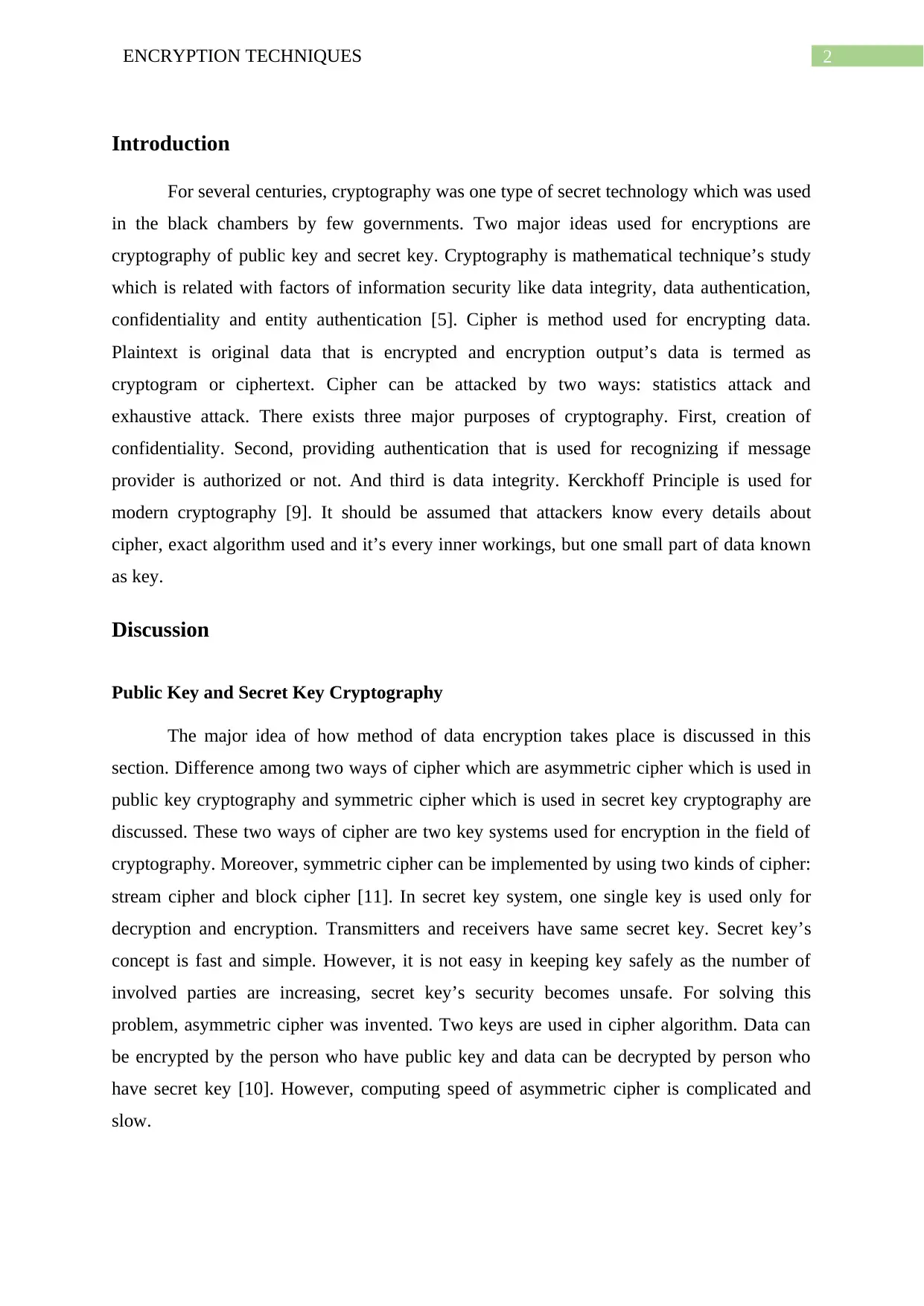
2ENCRYPTION TECHNIQUES
Introduction
For several centuries, cryptography was one type of secret technology which was used
in the black chambers by few governments. Two major ideas used for encryptions are
cryptography of public key and secret key. Cryptography is mathematical technique’s study
which is related with factors of information security like data integrity, data authentication,
confidentiality and entity authentication [5]. Cipher is method used for encrypting data.
Plaintext is original data that is encrypted and encryption output’s data is termed as
cryptogram or ciphertext. Cipher can be attacked by two ways: statistics attack and
exhaustive attack. There exists three major purposes of cryptography. First, creation of
confidentiality. Second, providing authentication that is used for recognizing if message
provider is authorized or not. And third is data integrity. Kerckhoff Principle is used for
modern cryptography [9]. It should be assumed that attackers know every details about
cipher, exact algorithm used and it’s every inner workings, but one small part of data known
as key.
Discussion
Public Key and Secret Key Cryptography
The major idea of how method of data encryption takes place is discussed in this
section. Difference among two ways of cipher which are asymmetric cipher which is used in
public key cryptography and symmetric cipher which is used in secret key cryptography are
discussed. These two ways of cipher are two key systems used for encryption in the field of
cryptography. Moreover, symmetric cipher can be implemented by using two kinds of cipher:
stream cipher and block cipher [11]. In secret key system, one single key is used only for
decryption and encryption. Transmitters and receivers have same secret key. Secret key’s
concept is fast and simple. However, it is not easy in keeping key safely as the number of
involved parties are increasing, secret key’s security becomes unsafe. For solving this
problem, asymmetric cipher was invented. Two keys are used in cipher algorithm. Data can
be encrypted by the person who have public key and data can be decrypted by person who
have secret key [10]. However, computing speed of asymmetric cipher is complicated and
slow.
Introduction
For several centuries, cryptography was one type of secret technology which was used
in the black chambers by few governments. Two major ideas used for encryptions are
cryptography of public key and secret key. Cryptography is mathematical technique’s study
which is related with factors of information security like data integrity, data authentication,
confidentiality and entity authentication [5]. Cipher is method used for encrypting data.
Plaintext is original data that is encrypted and encryption output’s data is termed as
cryptogram or ciphertext. Cipher can be attacked by two ways: statistics attack and
exhaustive attack. There exists three major purposes of cryptography. First, creation of
confidentiality. Second, providing authentication that is used for recognizing if message
provider is authorized or not. And third is data integrity. Kerckhoff Principle is used for
modern cryptography [9]. It should be assumed that attackers know every details about
cipher, exact algorithm used and it’s every inner workings, but one small part of data known
as key.
Discussion
Public Key and Secret Key Cryptography
The major idea of how method of data encryption takes place is discussed in this
section. Difference among two ways of cipher which are asymmetric cipher which is used in
public key cryptography and symmetric cipher which is used in secret key cryptography are
discussed. These two ways of cipher are two key systems used for encryption in the field of
cryptography. Moreover, symmetric cipher can be implemented by using two kinds of cipher:
stream cipher and block cipher [11]. In secret key system, one single key is used only for
decryption and encryption. Transmitters and receivers have same secret key. Secret key’s
concept is fast and simple. However, it is not easy in keeping key safely as the number of
involved parties are increasing, secret key’s security becomes unsafe. For solving this
problem, asymmetric cipher was invented. Two keys are used in cipher algorithm. Data can
be encrypted by the person who have public key and data can be decrypted by person who
have secret key [10]. However, computing speed of asymmetric cipher is complicated and
slow.
⊘ This is a preview!⊘
Do you want full access?
Subscribe today to unlock all pages.

Trusted by 1+ million students worldwide
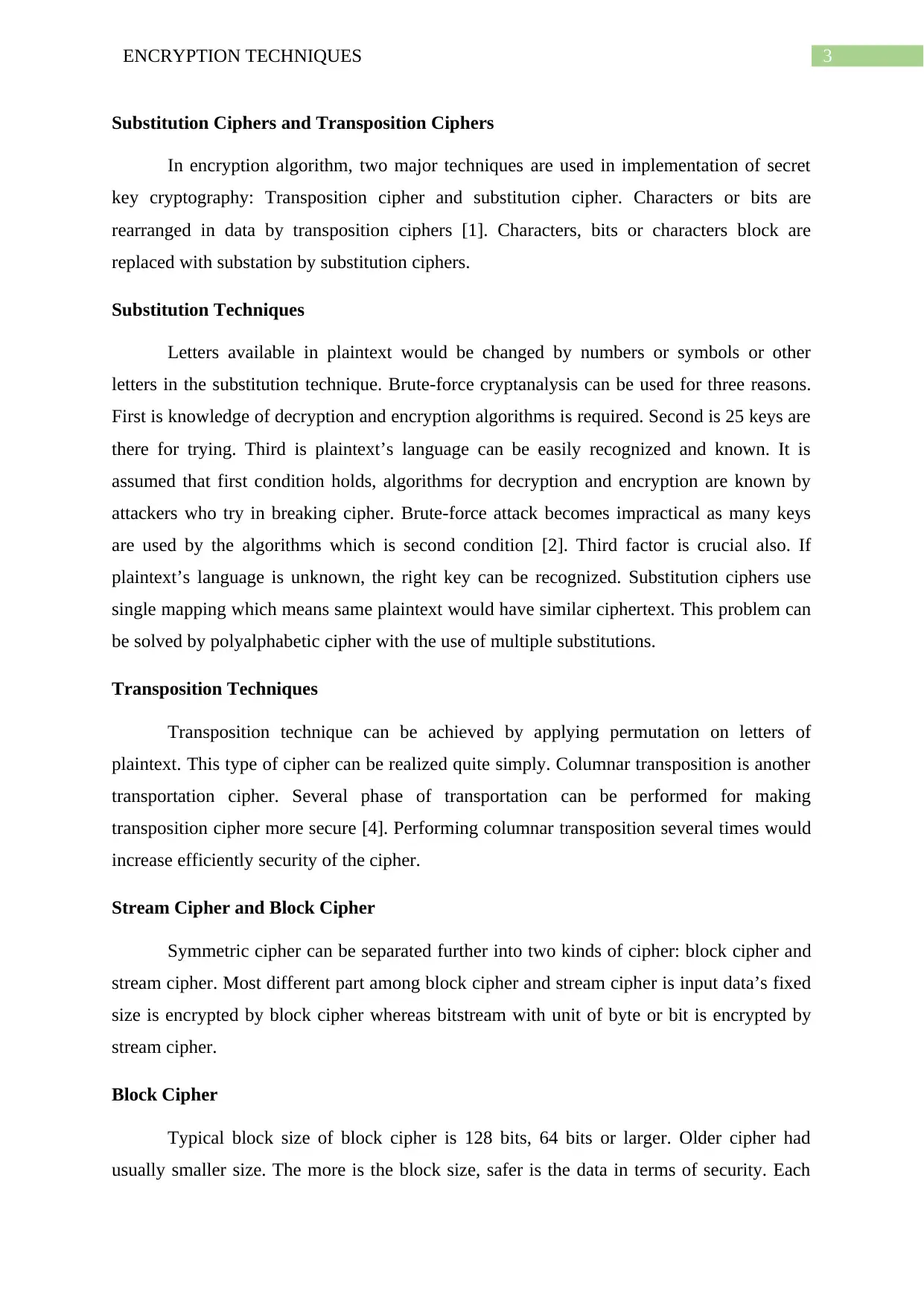
3ENCRYPTION TECHNIQUES
Substitution Ciphers and Transposition Ciphers
In encryption algorithm, two major techniques are used in implementation of secret
key cryptography: Transposition cipher and substitution cipher. Characters or bits are
rearranged in data by transposition ciphers [1]. Characters, bits or characters block are
replaced with substation by substitution ciphers.
Substitution Techniques
Letters available in plaintext would be changed by numbers or symbols or other
letters in the substitution technique. Brute-force cryptanalysis can be used for three reasons.
First is knowledge of decryption and encryption algorithms is required. Second is 25 keys are
there for trying. Third is plaintext’s language can be easily recognized and known. It is
assumed that first condition holds, algorithms for decryption and encryption are known by
attackers who try in breaking cipher. Brute-force attack becomes impractical as many keys
are used by the algorithms which is second condition [2]. Third factor is crucial also. If
plaintext’s language is unknown, the right key can be recognized. Substitution ciphers use
single mapping which means same plaintext would have similar ciphertext. This problem can
be solved by polyalphabetic cipher with the use of multiple substitutions.
Transposition Techniques
Transposition technique can be achieved by applying permutation on letters of
plaintext. This type of cipher can be realized quite simply. Columnar transposition is another
transportation cipher. Several phase of transportation can be performed for making
transposition cipher more secure [4]. Performing columnar transposition several times would
increase efficiently security of the cipher.
Stream Cipher and Block Cipher
Symmetric cipher can be separated further into two kinds of cipher: block cipher and
stream cipher. Most different part among block cipher and stream cipher is input data’s fixed
size is encrypted by block cipher whereas bitstream with unit of byte or bit is encrypted by
stream cipher.
Block Cipher
Typical block size of block cipher is 128 bits, 64 bits or larger. Older cipher had
usually smaller size. The more is the block size, safer is the data in terms of security. Each
Substitution Ciphers and Transposition Ciphers
In encryption algorithm, two major techniques are used in implementation of secret
key cryptography: Transposition cipher and substitution cipher. Characters or bits are
rearranged in data by transposition ciphers [1]. Characters, bits or characters block are
replaced with substation by substitution ciphers.
Substitution Techniques
Letters available in plaintext would be changed by numbers or symbols or other
letters in the substitution technique. Brute-force cryptanalysis can be used for three reasons.
First is knowledge of decryption and encryption algorithms is required. Second is 25 keys are
there for trying. Third is plaintext’s language can be easily recognized and known. It is
assumed that first condition holds, algorithms for decryption and encryption are known by
attackers who try in breaking cipher. Brute-force attack becomes impractical as many keys
are used by the algorithms which is second condition [2]. Third factor is crucial also. If
plaintext’s language is unknown, the right key can be recognized. Substitution ciphers use
single mapping which means same plaintext would have similar ciphertext. This problem can
be solved by polyalphabetic cipher with the use of multiple substitutions.
Transposition Techniques
Transposition technique can be achieved by applying permutation on letters of
plaintext. This type of cipher can be realized quite simply. Columnar transposition is another
transportation cipher. Several phase of transportation can be performed for making
transposition cipher more secure [4]. Performing columnar transposition several times would
increase efficiently security of the cipher.
Stream Cipher and Block Cipher
Symmetric cipher can be separated further into two kinds of cipher: block cipher and
stream cipher. Most different part among block cipher and stream cipher is input data’s fixed
size is encrypted by block cipher whereas bitstream with unit of byte or bit is encrypted by
stream cipher.
Block Cipher
Typical block size of block cipher is 128 bits, 64 bits or larger. Older cipher had
usually smaller size. The more is the block size, safer is the data in terms of security. Each
Paraphrase This Document
Need a fresh take? Get an instant paraphrase of this document with our AI Paraphraser
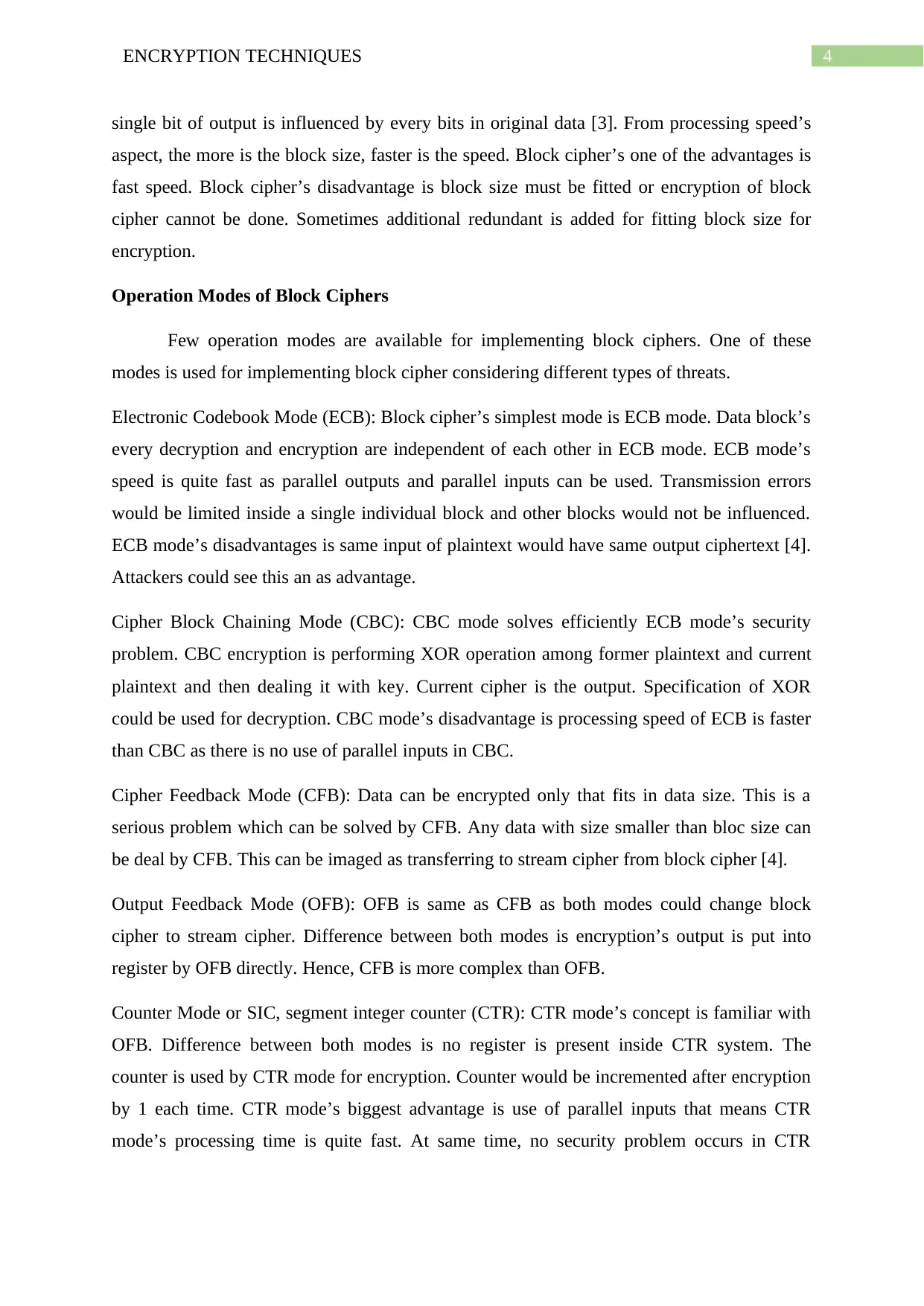
4ENCRYPTION TECHNIQUES
single bit of output is influenced by every bits in original data [3]. From processing speed’s
aspect, the more is the block size, faster is the speed. Block cipher’s one of the advantages is
fast speed. Block cipher’s disadvantage is block size must be fitted or encryption of block
cipher cannot be done. Sometimes additional redundant is added for fitting block size for
encryption.
Operation Modes of Block Ciphers
Few operation modes are available for implementing block ciphers. One of these
modes is used for implementing block cipher considering different types of threats.
Electronic Codebook Mode (ECB): Block cipher’s simplest mode is ECB mode. Data block’s
every decryption and encryption are independent of each other in ECB mode. ECB mode’s
speed is quite fast as parallel outputs and parallel inputs can be used. Transmission errors
would be limited inside a single individual block and other blocks would not be influenced.
ECB mode’s disadvantages is same input of plaintext would have same output ciphertext [4].
Attackers could see this an as advantage.
Cipher Block Chaining Mode (CBC): CBC mode solves efficiently ECB mode’s security
problem. CBC encryption is performing XOR operation among former plaintext and current
plaintext and then dealing it with key. Current cipher is the output. Specification of XOR
could be used for decryption. CBC mode’s disadvantage is processing speed of ECB is faster
than CBC as there is no use of parallel inputs in CBC.
Cipher Feedback Mode (CFB): Data can be encrypted only that fits in data size. This is a
serious problem which can be solved by CFB. Any data with size smaller than bloc size can
be deal by CFB. This can be imaged as transferring to stream cipher from block cipher [4].
Output Feedback Mode (OFB): OFB is same as CFB as both modes could change block
cipher to stream cipher. Difference between both modes is encryption’s output is put into
register by OFB directly. Hence, CFB is more complex than OFB.
Counter Mode or SIC, segment integer counter (CTR): CTR mode’s concept is familiar with
OFB. Difference between both modes is no register is present inside CTR system. The
counter is used by CTR mode for encryption. Counter would be incremented after encryption
by 1 each time. CTR mode’s biggest advantage is use of parallel inputs that means CTR
mode’s processing time is quite fast. At same time, no security problem occurs in CTR
single bit of output is influenced by every bits in original data [3]. From processing speed’s
aspect, the more is the block size, faster is the speed. Block cipher’s one of the advantages is
fast speed. Block cipher’s disadvantage is block size must be fitted or encryption of block
cipher cannot be done. Sometimes additional redundant is added for fitting block size for
encryption.
Operation Modes of Block Ciphers
Few operation modes are available for implementing block ciphers. One of these
modes is used for implementing block cipher considering different types of threats.
Electronic Codebook Mode (ECB): Block cipher’s simplest mode is ECB mode. Data block’s
every decryption and encryption are independent of each other in ECB mode. ECB mode’s
speed is quite fast as parallel outputs and parallel inputs can be used. Transmission errors
would be limited inside a single individual block and other blocks would not be influenced.
ECB mode’s disadvantages is same input of plaintext would have same output ciphertext [4].
Attackers could see this an as advantage.
Cipher Block Chaining Mode (CBC): CBC mode solves efficiently ECB mode’s security
problem. CBC encryption is performing XOR operation among former plaintext and current
plaintext and then dealing it with key. Current cipher is the output. Specification of XOR
could be used for decryption. CBC mode’s disadvantage is processing speed of ECB is faster
than CBC as there is no use of parallel inputs in CBC.
Cipher Feedback Mode (CFB): Data can be encrypted only that fits in data size. This is a
serious problem which can be solved by CFB. Any data with size smaller than bloc size can
be deal by CFB. This can be imaged as transferring to stream cipher from block cipher [4].
Output Feedback Mode (OFB): OFB is same as CFB as both modes could change block
cipher to stream cipher. Difference between both modes is encryption’s output is put into
register by OFB directly. Hence, CFB is more complex than OFB.
Counter Mode or SIC, segment integer counter (CTR): CTR mode’s concept is familiar with
OFB. Difference between both modes is no register is present inside CTR system. The
counter is used by CTR mode for encryption. Counter would be incremented after encryption
by 1 each time. CTR mode’s biggest advantage is use of parallel inputs that means CTR
mode’s processing time is quite fast. At same time, no security problem occurs in CTR
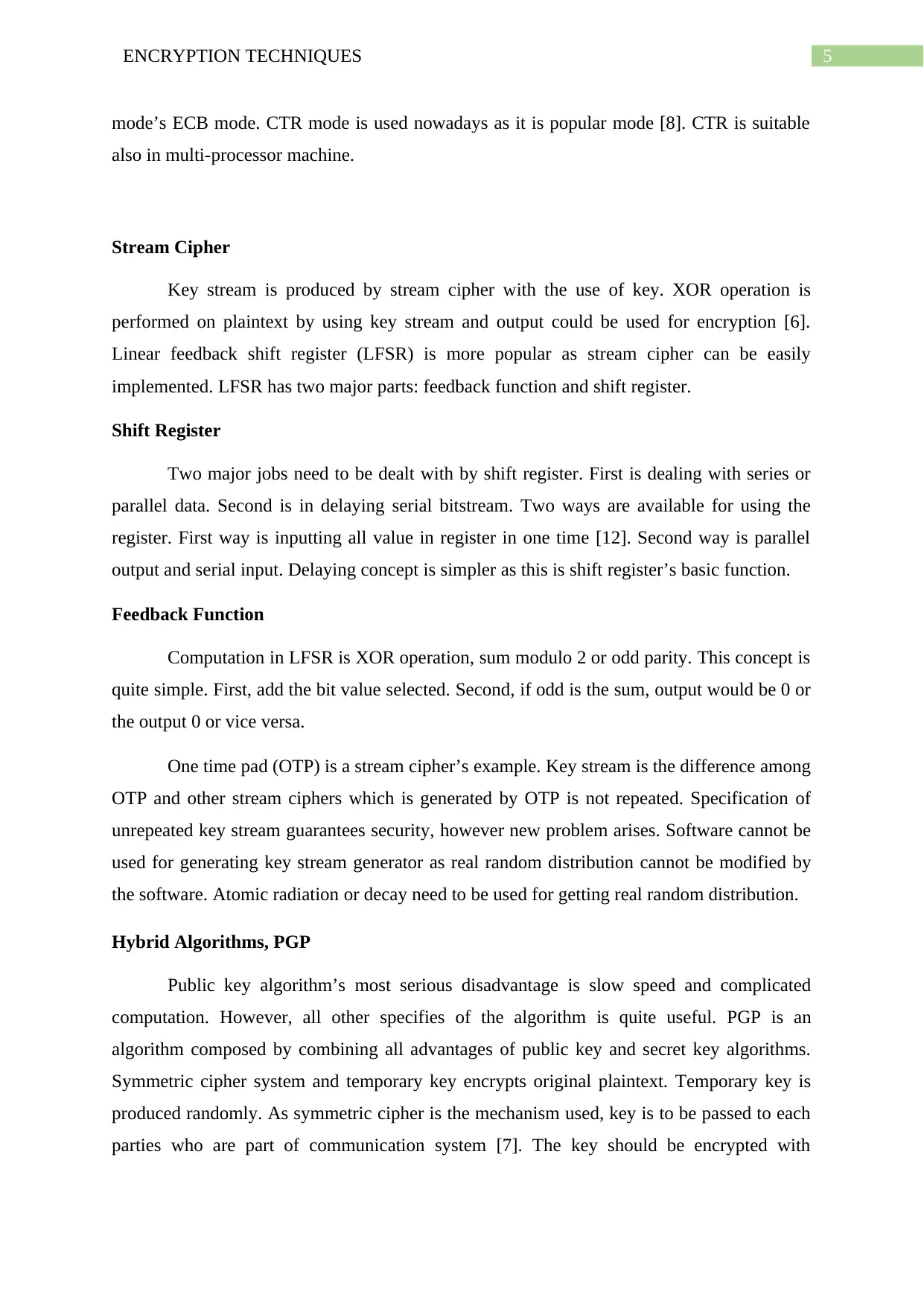
5ENCRYPTION TECHNIQUES
mode’s ECB mode. CTR mode is used nowadays as it is popular mode [8]. CTR is suitable
also in multi-processor machine.
Stream Cipher
Key stream is produced by stream cipher with the use of key. XOR operation is
performed on plaintext by using key stream and output could be used for encryption [6].
Linear feedback shift register (LFSR) is more popular as stream cipher can be easily
implemented. LFSR has two major parts: feedback function and shift register.
Shift Register
Two major jobs need to be dealt with by shift register. First is dealing with series or
parallel data. Second is in delaying serial bitstream. Two ways are available for using the
register. First way is inputting all value in register in one time [12]. Second way is parallel
output and serial input. Delaying concept is simpler as this is shift register’s basic function.
Feedback Function
Computation in LFSR is XOR operation, sum modulo 2 or odd parity. This concept is
quite simple. First, add the bit value selected. Second, if odd is the sum, output would be 0 or
the output 0 or vice versa.
One time pad (OTP) is a stream cipher’s example. Key stream is the difference among
OTP and other stream ciphers which is generated by OTP is not repeated. Specification of
unrepeated key stream guarantees security, however new problem arises. Software cannot be
used for generating key stream generator as real random distribution cannot be modified by
the software. Atomic radiation or decay need to be used for getting real random distribution.
Hybrid Algorithms, PGP
Public key algorithm’s most serious disadvantage is slow speed and complicated
computation. However, all other specifies of the algorithm is quite useful. PGP is an
algorithm composed by combining all advantages of public key and secret key algorithms.
Symmetric cipher system and temporary key encrypts original plaintext. Temporary key is
produced randomly. As symmetric cipher is the mechanism used, key is to be passed to each
parties who are part of communication system [7]. The key should be encrypted with
mode’s ECB mode. CTR mode is used nowadays as it is popular mode [8]. CTR is suitable
also in multi-processor machine.
Stream Cipher
Key stream is produced by stream cipher with the use of key. XOR operation is
performed on plaintext by using key stream and output could be used for encryption [6].
Linear feedback shift register (LFSR) is more popular as stream cipher can be easily
implemented. LFSR has two major parts: feedback function and shift register.
Shift Register
Two major jobs need to be dealt with by shift register. First is dealing with series or
parallel data. Second is in delaying serial bitstream. Two ways are available for using the
register. First way is inputting all value in register in one time [12]. Second way is parallel
output and serial input. Delaying concept is simpler as this is shift register’s basic function.
Feedback Function
Computation in LFSR is XOR operation, sum modulo 2 or odd parity. This concept is
quite simple. First, add the bit value selected. Second, if odd is the sum, output would be 0 or
the output 0 or vice versa.
One time pad (OTP) is a stream cipher’s example. Key stream is the difference among
OTP and other stream ciphers which is generated by OTP is not repeated. Specification of
unrepeated key stream guarantees security, however new problem arises. Software cannot be
used for generating key stream generator as real random distribution cannot be modified by
the software. Atomic radiation or decay need to be used for getting real random distribution.
Hybrid Algorithms, PGP
Public key algorithm’s most serious disadvantage is slow speed and complicated
computation. However, all other specifies of the algorithm is quite useful. PGP is an
algorithm composed by combining all advantages of public key and secret key algorithms.
Symmetric cipher system and temporary key encrypts original plaintext. Temporary key is
produced randomly. As symmetric cipher is the mechanism used, key is to be passed to each
parties who are part of communication system [7]. The key should be encrypted with
⊘ This is a preview!⊘
Do you want full access?
Subscribe today to unlock all pages.

Trusted by 1+ million students worldwide
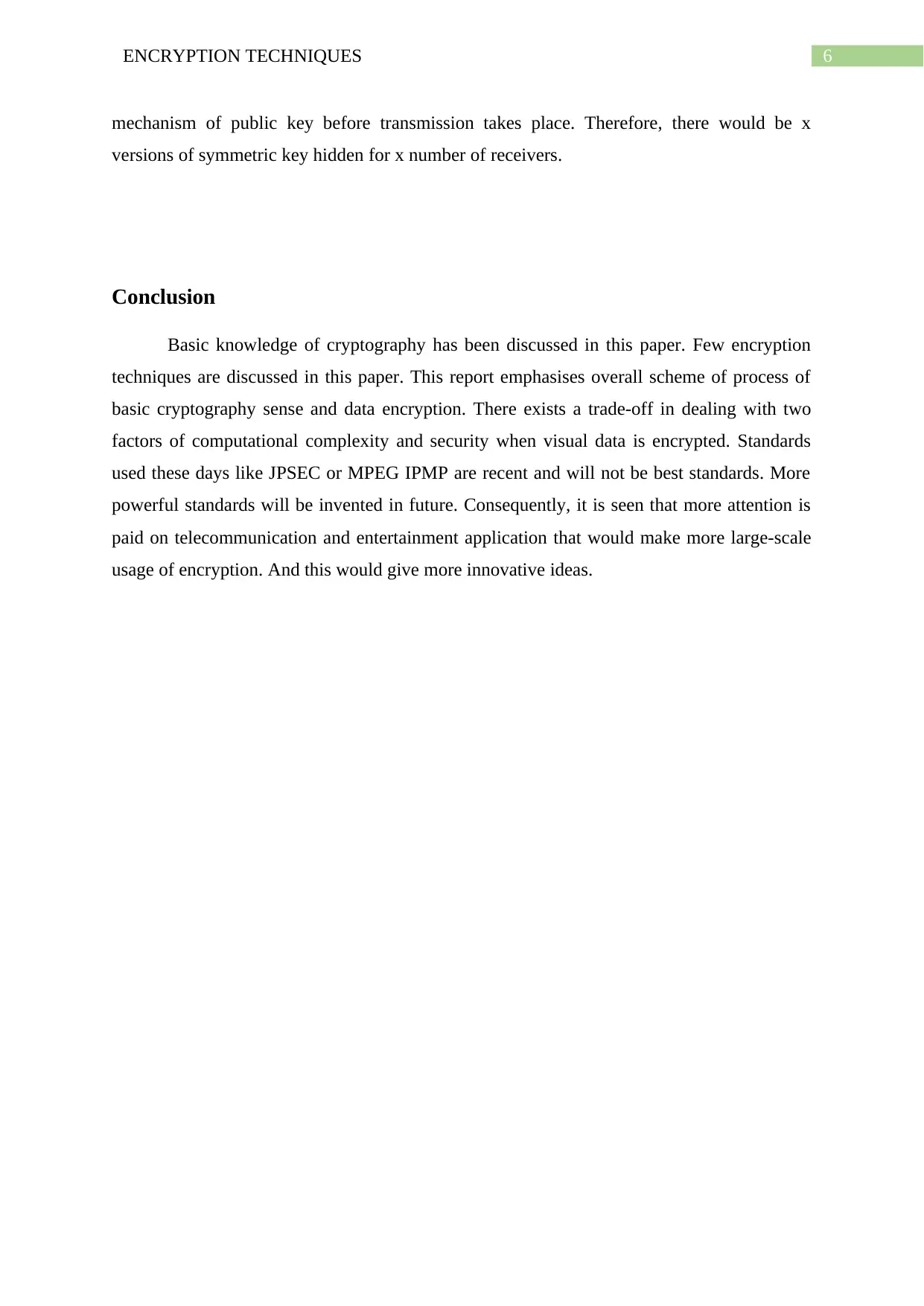
6ENCRYPTION TECHNIQUES
mechanism of public key before transmission takes place. Therefore, there would be x
versions of symmetric key hidden for x number of receivers.
Conclusion
Basic knowledge of cryptography has been discussed in this paper. Few encryption
techniques are discussed in this paper. This report emphasises overall scheme of process of
basic cryptography sense and data encryption. There exists a trade-off in dealing with two
factors of computational complexity and security when visual data is encrypted. Standards
used these days like JPSEC or MPEG IPMP are recent and will not be best standards. More
powerful standards will be invented in future. Consequently, it is seen that more attention is
paid on telecommunication and entertainment application that would make more large-scale
usage of encryption. And this would give more innovative ideas.
mechanism of public key before transmission takes place. Therefore, there would be x
versions of symmetric key hidden for x number of receivers.
Conclusion
Basic knowledge of cryptography has been discussed in this paper. Few encryption
techniques are discussed in this paper. This report emphasises overall scheme of process of
basic cryptography sense and data encryption. There exists a trade-off in dealing with two
factors of computational complexity and security when visual data is encrypted. Standards
used these days like JPSEC or MPEG IPMP are recent and will not be best standards. More
powerful standards will be invented in future. Consequently, it is seen that more attention is
paid on telecommunication and entertainment application that would make more large-scale
usage of encryption. And this would give more innovative ideas.
Paraphrase This Document
Need a fresh take? Get an instant paraphrase of this document with our AI Paraphraser
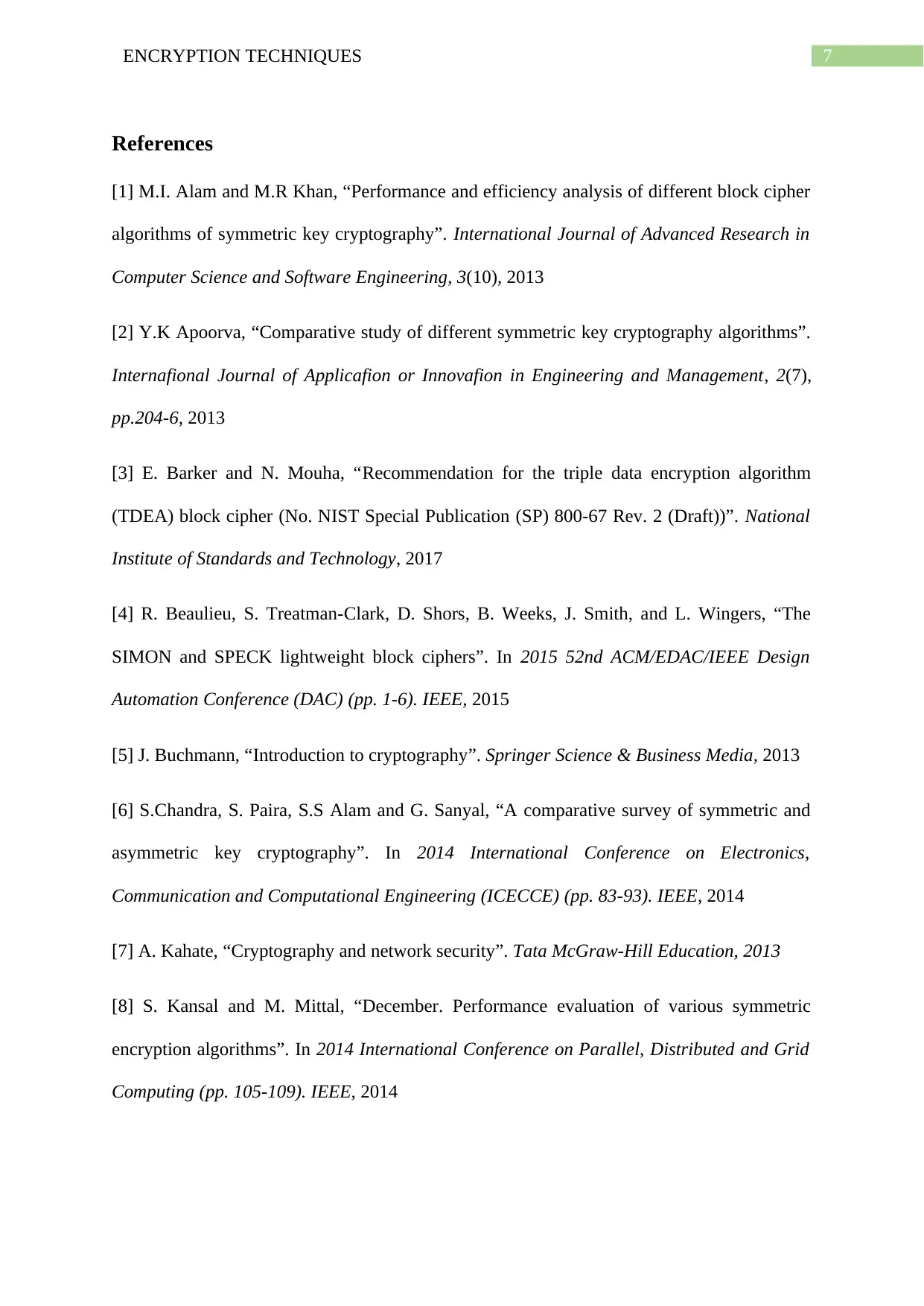
7ENCRYPTION TECHNIQUES
References
[1] M.I. Alam and M.R Khan, “Performance and efficiency analysis of different block cipher
algorithms of symmetric key cryptography”. International Journal of Advanced Research in
Computer Science and Software Engineering, 3(10), 2013
[2] Y.K Apoorva, “Comparative study of different symmetric key cryptography algorithms”.
Internafional Journal of Applicafion or Innovafion in Engineering and Management, 2(7),
pp.204-6, 2013
[3] E. Barker and N. Mouha, “Recommendation for the triple data encryption algorithm
(TDEA) block cipher (No. NIST Special Publication (SP) 800-67 Rev. 2 (Draft))”. National
Institute of Standards and Technology, 2017
[4] R. Beaulieu, S. Treatman-Clark, D. Shors, B. Weeks, J. Smith, and L. Wingers, “The
SIMON and SPECK lightweight block ciphers”. In 2015 52nd ACM/EDAC/IEEE Design
Automation Conference (DAC) (pp. 1-6). IEEE, 2015
[5] J. Buchmann, “Introduction to cryptography”. Springer Science & Business Media, 2013
[6] S.Chandra, S. Paira, S.S Alam and G. Sanyal, “A comparative survey of symmetric and
asymmetric key cryptography”. In 2014 International Conference on Electronics,
Communication and Computational Engineering (ICECCE) (pp. 83-93). IEEE, 2014
[7] A. Kahate, “Cryptography and network security”. Tata McGraw-Hill Education, 2013
[8] S. Kansal and M. Mittal, “December. Performance evaluation of various symmetric
encryption algorithms”. In 2014 International Conference on Parallel, Distributed and Grid
Computing (pp. 105-109). IEEE, 2014
References
[1] M.I. Alam and M.R Khan, “Performance and efficiency analysis of different block cipher
algorithms of symmetric key cryptography”. International Journal of Advanced Research in
Computer Science and Software Engineering, 3(10), 2013
[2] Y.K Apoorva, “Comparative study of different symmetric key cryptography algorithms”.
Internafional Journal of Applicafion or Innovafion in Engineering and Management, 2(7),
pp.204-6, 2013
[3] E. Barker and N. Mouha, “Recommendation for the triple data encryption algorithm
(TDEA) block cipher (No. NIST Special Publication (SP) 800-67 Rev. 2 (Draft))”. National
Institute of Standards and Technology, 2017
[4] R. Beaulieu, S. Treatman-Clark, D. Shors, B. Weeks, J. Smith, and L. Wingers, “The
SIMON and SPECK lightweight block ciphers”. In 2015 52nd ACM/EDAC/IEEE Design
Automation Conference (DAC) (pp. 1-6). IEEE, 2015
[5] J. Buchmann, “Introduction to cryptography”. Springer Science & Business Media, 2013
[6] S.Chandra, S. Paira, S.S Alam and G. Sanyal, “A comparative survey of symmetric and
asymmetric key cryptography”. In 2014 International Conference on Electronics,
Communication and Computational Engineering (ICECCE) (pp. 83-93). IEEE, 2014
[7] A. Kahate, “Cryptography and network security”. Tata McGraw-Hill Education, 2013
[8] S. Kansal and M. Mittal, “December. Performance evaluation of various symmetric
encryption algorithms”. In 2014 International Conference on Parallel, Distributed and Grid
Computing (pp. 105-109). IEEE, 2014
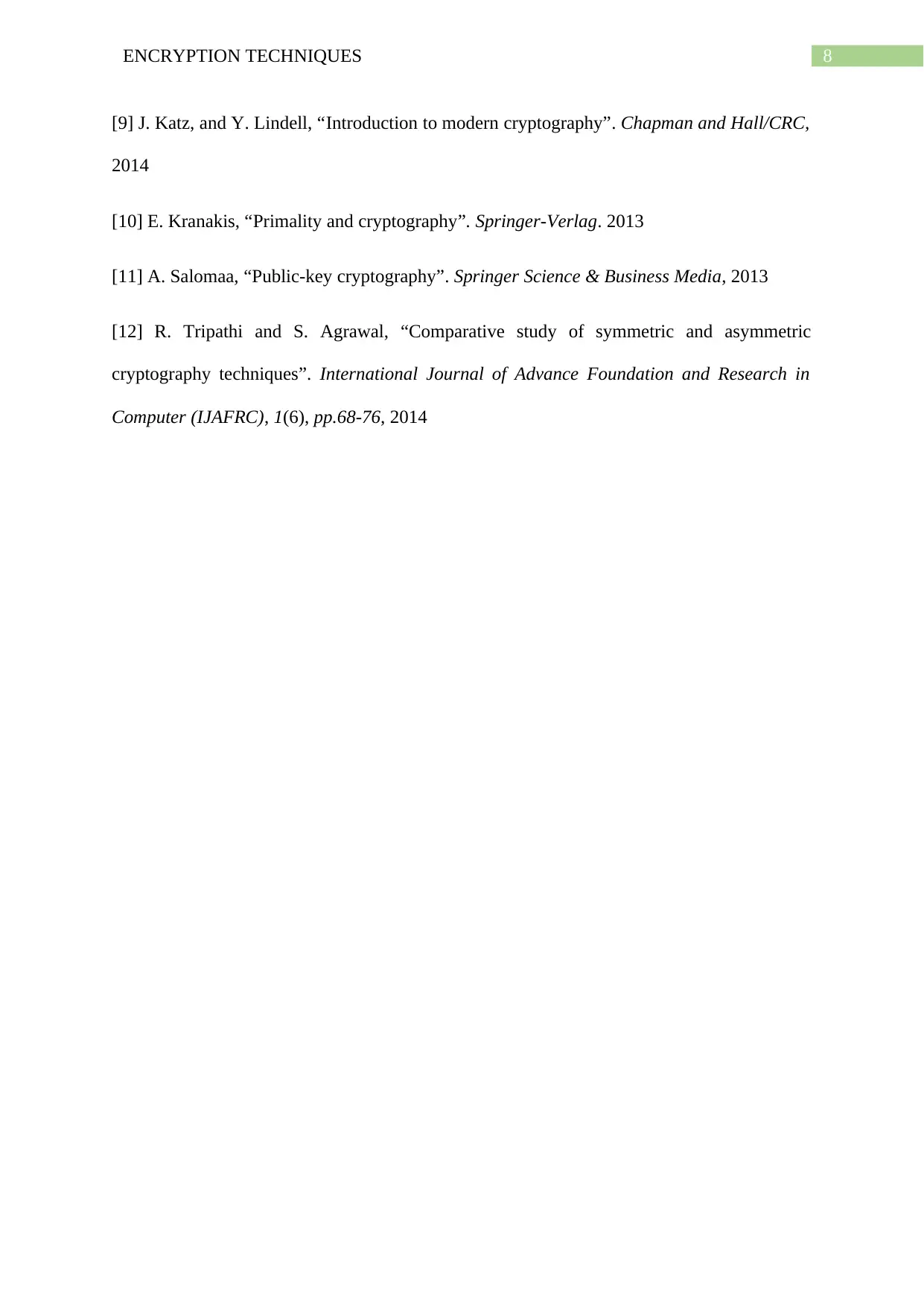
8ENCRYPTION TECHNIQUES
[9] J. Katz, and Y. Lindell, “Introduction to modern cryptography”. Chapman and Hall/CRC,
2014
[10] E. Kranakis, “Primality and cryptography”. Springer-Verlag. 2013
[11] A. Salomaa, “Public-key cryptography”. Springer Science & Business Media, 2013
[12] R. Tripathi and S. Agrawal, “Comparative study of symmetric and asymmetric
cryptography techniques”. International Journal of Advance Foundation and Research in
Computer (IJAFRC), 1(6), pp.68-76, 2014
[9] J. Katz, and Y. Lindell, “Introduction to modern cryptography”. Chapman and Hall/CRC,
2014
[10] E. Kranakis, “Primality and cryptography”. Springer-Verlag. 2013
[11] A. Salomaa, “Public-key cryptography”. Springer Science & Business Media, 2013
[12] R. Tripathi and S. Agrawal, “Comparative study of symmetric and asymmetric
cryptography techniques”. International Journal of Advance Foundation and Research in
Computer (IJAFRC), 1(6), pp.68-76, 2014
⊘ This is a preview!⊘
Do you want full access?
Subscribe today to unlock all pages.

Trusted by 1+ million students worldwide
1 out of 9
Related Documents
Your All-in-One AI-Powered Toolkit for Academic Success.
+13062052269
info@desklib.com
Available 24*7 on WhatsApp / Email
![[object Object]](/_next/static/media/star-bottom.7253800d.svg)
Unlock your academic potential
Copyright © 2020–2025 A2Z Services. All Rights Reserved. Developed and managed by ZUCOL.





